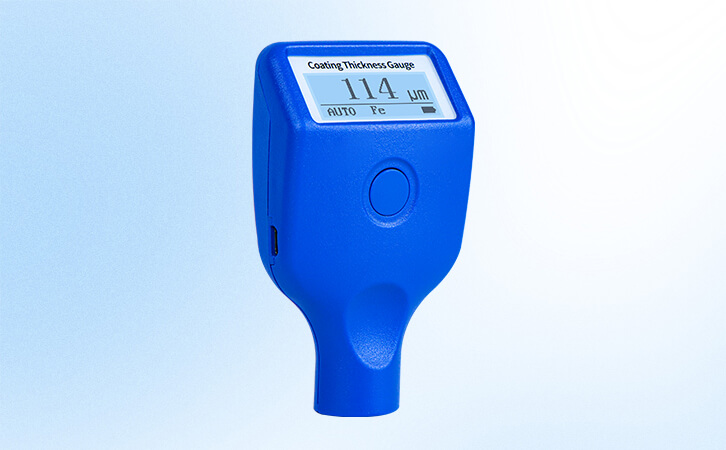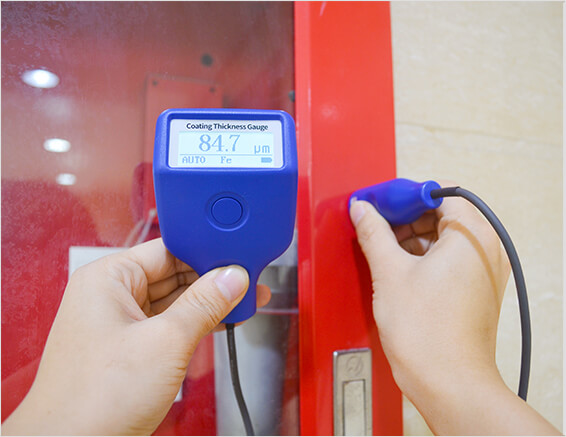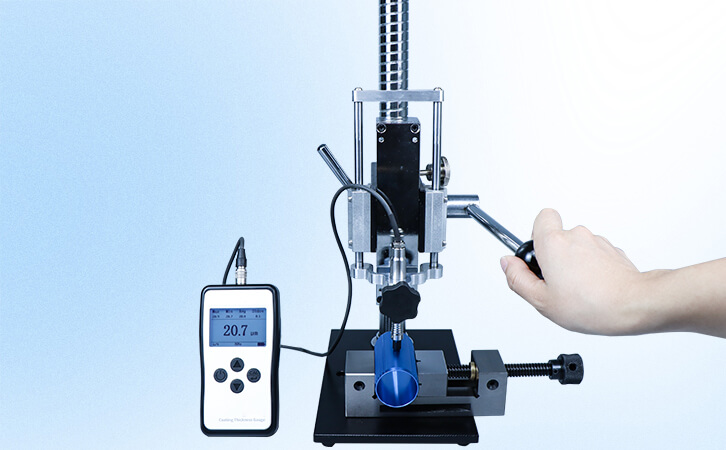MetriTec™ Coating Thickness Gauge
For more information please contact us at contact@acsmaterial.com
Product Detail
MetriTec™ Coating Thickness Gauge M220H is an integrated high-precision coating thickness gauge, which combines the Hall effect and Eddy current thickness measurement principles. Based on the Hall effect, the instrument can measure non-ferromagnetic coatings on ferromagnetic metal substrates, while under the Eddy current principle effect, it can measure non-conductive coatings on non-magnetic metal substrates.
- There are only four types of ferromagnetic metal elements at room temperature: iron, cobalt, nickel, and gadolinium.
- Common non-ferromagnetic metals: copper, aluminum, zinc, chromium, etc.
- Hall effect: can be used for the measurement of non-ferromagnetic coatings on ferromagnetic metal substrates.
- Eddy current: can be used for the measurement of non-conductive coatings on non-magnetic metal substrates.

MetriTec™ Coating Thickness Gauge M221 Coating Thickness Gauge is a specialist instrument for measuring the thickness of coatings on metal surfaces. The instrument combines the Hall effect and Eddy current principles to measure the thickness of non-ferromagnetic coatings on ferromagnetic metal substrates and the thickness of non-conductive coatings on non-magnetic metal substrates. The host and probe of M221 is separate, which makes it easy for the user to view the data under complex testing conditions. It can be used in the laboratory and engineering field.
-
Hall Effect: can be used for the measurement of non-ferromagnetic coatings on ferromagnetic metal substrates.
-
Eddy current: can be used for the measurement of non-conductive coatings on non-magnetic metal substrates.
-
There are only four types of ferromagnetic metal elements at room temperature: iron, cobalt, nickel, and gadolinium.
-
Common non-ferromagnetic metals: copper, aluminum, zinc, chromium, etc.

MetriTec™ Coating Thickness Gauge M225+N1500 is a split type plating thickness tester, which consists of the host and the digital probe N1500. It adopts the eddy current induction principle and has ultra-high measurement accuracy and repeatability which is especially suitable for measuring ultra-thin coatings and various small-sized work pieces and special-shaped materials. Its plating thickness tester can be used in production inspection, construction acceptance as well as sales and exhibition sites. It can quickly and non-destructively measure the thickness of non-conductive coating on non-magnetic metal substrates. This plating thickness measurement device can be used in industries such as aviation, building materials, machinery, chemicals, engineering and instrumentation, etc.

FAQ:
Choosing the right model for your application
The choice of the most suitable method for measuring paint or coating thickness depends on several factors, including the type of coating, substrate material, coating thickness range, size and shape of the part, and equipment cost.
|
Model/SKU# |
Principles |
Accuracy |
Measuring Area |
Measuring Range |
Best for |
|
MetriTec™ Coating Thickness Gauge M220H ELCG220H |
Fe: Hall Effect NFe: Eddy current |
≤±(3% H +2μm) |
Ø > 25mm |
0.0-5000μm |
Conventional coating |
|
MetriTec™ Coating Thickness Gauge M221 ELCG221 |
Coating in confined spaces |
||||
|
MetriTec™ Coating Thickness Gauge M225+F500 ELCG22501 |
Magnetic Induction |
≤±(2%H+0.3μm) after 5 points calibration |
Ø > 7mm |
0.0-500μm |
Ultra-thin electroplated coating |
|
MetriTec™ Coating Thickness Gauge M225+N1500 ELCG22502 |
Eddy current |
0.0-1500μm |
Ultra-thin anodized layer |
||
|
MetriTec™ Coating Thickness Gauge M225+N2000 ELCG22503 |
Eddy current |
Ø > 30mm |
0.0-2000μm |
Large-area panel coating, PCB coating |
1. Built-in sensor or an external sensor probe?
-
The M220H portable coating thickness gauge has integrated probe, which can be operated with one hand. The operation is relatively simple. Lightweight and portable design for on-site measurements.
-
The M221 and M225 coating thickness gauges have external probes. The probes of these three coating thickness gauges are connected to the host through a line. The probe is very small and can be placed in a narrow space or used when the measured position is higher or lower. We can use another hand to hold the gauge, so we can easily read the data.
2. Ultra-small size or irregular shaped workpiece?
-
If you want to measure a metal material with a special shape or a small size and a large arc, please choose the M225 coating thickness gauge. M225 plating thickness tester has two probes: F500 and N1500.
M225+F500 plating thickness tester is used to measure the coating thickness on ferrous metal substrates. Its coating thickness measuring range is 0.0-500μm.
M225+N1500 plating thickness tester is used to measure the coating thickness on non-ferrous metal substrates. Its coating thickness measuring range is 0.0-1500μm.
-
If the diameter of the material you measure is greater than 25 mm and there is no obvious arc, please choose M220H and M221 coating thickness gauges.
All coating thickness gauge meets ISO and ASTM compliance, making it the best coating thickness gauge for industrial applications.
3. Large thickness, ordinary coating, or ultra-thin plating?
-
For ultra-thin plating layer measurement (<20μm): Please choose the M225 plating thickness gauge with the F500 probe.
-
For precise measurement of ultra-thin anodized layers on aluminum substrates, we recommend using the M225 Eddy Current Thickness Gauge paired with the N1500 probe.
-
For coating thickness measurement within 5000μm (5mm): Please choose the M220H or M221 coating thickness gauge.

